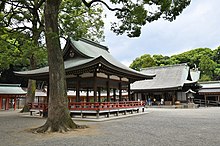User:Immanuelle/Hikawa Shrine (Saitama)
| This is not a Wikipedia article: It is one user's draft page that he or she is working on. It may be incomplete and/or unreliable. This page was last edited by Immanuelle (talk | contribs) 0 seconds ago. |
| Hikawa Shrine 氷川神社 | |
|---|---|
 Precincts of Hikawa Shrine | |
| Religion | |
| Affiliation | Shinto |
| Deity | Susanoo Kushinadahime Ōkuninushi Ashinazuchi Tenazuchi |
| Festival | Reitaisai (Annual main festival) (August 1) |
| Type | Hikawa shrine |
| Location | |
| Location | 1-407, Takahana-cho, Omiya-ku, Saitama-shi, Saitama, Japan |
| Geographic coordinates | 35°55′00″N 139°37′46″E / 35.91667°N 139.62944°E |
| Architecture | |
| Architectural style | Nagare-zukuri |
| Founder | Emperor Kōshō |
| Date established | 473 BC |
| Website | |
| Official website | |
| The English used in this user page may not be easy for everybody to understand. You can help Wikipedia by reading Wikipedia:How to write Simple English pages, then simplifying the page. |
Hikawa Shrine is a Shinto shrine in Saitama, Japan. It's one of two top ranked shrines of the old Musashi Province. It is tied with Ono Shrine
Top ranked shrines are called Ichinomiya or number one shrines.
Its main festival is on August 1 each year. [1]
The area of Omiya got its name, which means "Great Shrine", because Emperor Meiji liked Hikawa Shrine a lot. He made it the most important shrine in the Kantō region. There are about 280 Hikawa shrines, mostly in Kantō.[2]
Gods of the shrine[change | change source]
Gods at the Shrine:
- Susanoo-no-Mikoto (須佐之男命), brother of Amaterasu, god of sea, storms, fields, the harvest, marriage, and love
- Inada-hime no Mikoto (稲田姫命), wife of Susanoo, goddess of rice, agriculture, marriage, love, childbirth, and child rearing
- Ōnamuchi no Mikoto (大己貴命), god of nation-building, agriculture, medicine, and protective magic
History[change | change source]
The shrine started around 473 BC when the Musashi clan came to this area. They brought worship of Susanoo with them. There is a story about a hero, Yamato Takeru, who hurt his leg and got healed after praying here. The local area's old name, meaning "leg stand", comes from this story. A pond in the shrine is linked to a water god and an old swamp.[3][4] The shrine first appears in the historical record in an entry in the Nihon Sandai Jitsuroku which was compiled in 901. In the Engishiki records, it is listed as a myōjin taishi (名神大社).[3][4]
In history, many important people prayed here. Despite its importance, it wasn't always seen as the top shrine of Musashi Province. This changed over time. By the late Muromachi period, it was known as the top shrine.[3]
After the Meiji restoration in 1868, Emperor Meiji visited this shrine. In 1870, he made it an Imperial shrine, 1st rank (官幣大社, Kanpei-taisha) under the State Shinto Modern system of ranked Shinto shrines. The main shrine building was fixed up in 1882. In 1940, the government helped rebuild it. In 1976, a big gate from Meiji Shrine, damaged by lightning, was moved here.[3]
References[change | change source]
- ↑ Shibuya, Nobuhiro (2015). Shokoku jinja Ichinomiya Ninomiya San'nomiya (in Japanese). Yamakawa shuppansha. ISBN 978-4634150867.
- ↑ Nussbaum, Louis-Frédéric. (2005). "Hikawa-jinja" in Japan Encyclopedia, p. 311 at Google Books.
- ↑ 3.0 3.1 3.2 3.3 Yoshiki, Emi (2007). Zenkoku 'Ichinomiya' tettei gaido (in Japanese). PHP Institute. ISBN 978-4569669304.
- ↑ 4.0 4.1 "Nationwide List of Ichinomiya," p. 3. Archived 2013-05-17 at the Wayback Machine; retrieved 2011-08-09


